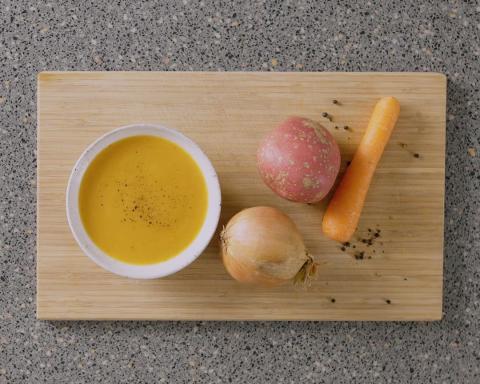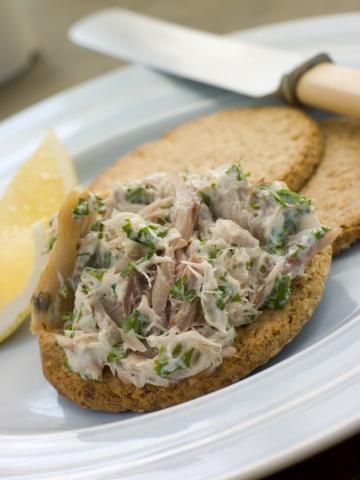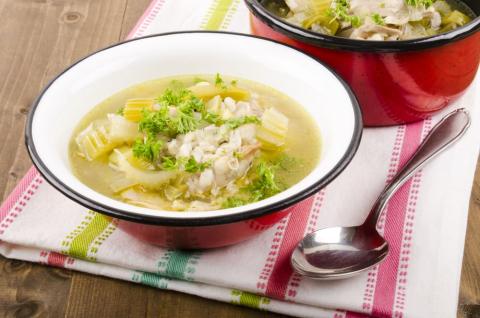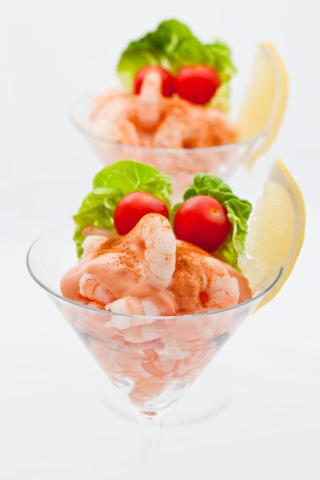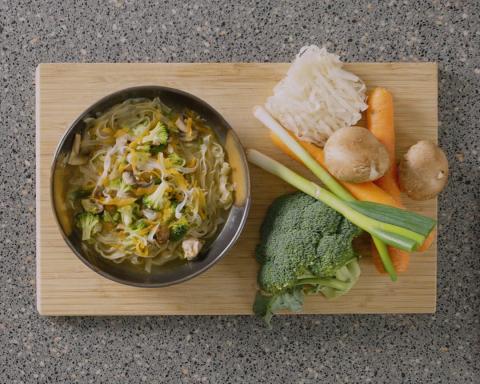- 8 Slices (200g) Back Bacon
- 2 (320g) Leeks
- 4 Medium sized (320g) Carrots
- 1 Pint (500ml) Water
- 2 Tablespoons (30g) Tomato Puree
- 1 Cup (100g) Pasta
- 2 Teaspoons (2g) Dried Parsley
- 1 Can (400g) Mixed Beans
- 1 (7g) Reduced Salt Stock Cube (Vegetable Or Chicken)
Ingredients
Allergy Disclaimer
Always check the label of each ingredient for allergy warnings.
Method
- Trim the fat off the bacon and cut into small squares. Fry it in a large pan and once it starts to brown drain off any excess fat
- Peel the carrots and cut in half lengthways then slice. Remove outer layers of the leeks then half lengthways and slice. Add both to the pan with bacon and cook for 5 minutes with the lid on
- Drain and rinse the beans. Dissolve stock cube in boiling water. Add beans, stock tomato puree and pasta to the pan and simmer until the pasta is cooked, approximately 10 minutes
- Once the pasta is cooked, stir through the parsely and serve
Time Saver Tips
Prepare soup in advance and when required add the pasta and cook
Cost Saver Tips
Make in bulk for another day
Tips for Kids
Let them add their favourite pasta shapes
Nutritional Information
Based on a single serving of 386g (% of an adult's reference intake)
Energy
328 kcals ( 16 %)
1,378 kJ ( 16 %)
Fat
3.5 g ( 17 %)
Saturates
38.6 g ( %)
Sugar
8.1 g ( 9 %)
Salt
2.3 g ( 38 %)
Detailed nutritional information
| Per 100g | Per 386g serving | |
|---|---|---|
| Energy Kcals | 85 | 328 |
| Energy Kj | 357 | 1,378 |
| Protein | 5 g | 19.3 g |
| Total Fat | g | g |
| Saturated Fat | 0.9 g | 3.5 g |
| Carbohydrates | 10 g | 38.6 g |
| Total Sugars | 2.1 g | 8.1 g |
| NSP Fibre | 2.3 g | 8.9 g |
| Sodium | 258 mg | 996 mg |
| Salt | 0.6 g | 2.3 g |
Find out about nutritional labelling
Nutrition labels on the front of packaging
- Most of the big supermarkets and many food manufacturers display nutritional information on the front of pre-packed food.
- Front of pack nutrition labels provide information on the number of grams of fat, saturated fat, sugars and salt and the amount of energy (in kJ and kcal) in a serving or portion of a recipe.
- The labels also include information about reference intakes (expressed as a percentage) which are guidelines about the approximate amount of particular nutrients and energy required for a healthy diet.
- The colour coding tells you at a glance if the food has high (red), medium (amber) or low (green) amounts of fat, saturated fat, sugars and salt.
- The more greens on the label, the healthier the choice
- Amber means neither high nor low, so you can eat foods with all or mostly ambers on the label most of the time.
- Reds on the label means the food is high in that nutrient and these are the foods we should cut down on. Try to eat these foods less often and in small amounts.
Food shopping tips
If you’re trying to decide which product to choose, check to see if there's a nutrition label on the front of the pack. This will help you to quickly assess how your choices stack up. You will often find a mixture of red, amber and green colour coding for the nutrients. So when you're choosing between similar products, try to go for more greens and ambers and fewer reds if you want to make a healthier choice.
 Activities & Play
Activities & Play Behaviour
Behaviour Childcare
Childcare Development & Growing Up
Development & Growing Up Family, Friends & Relationships
Family, Friends & Relationships Feeding Your Baby
Feeding Your Baby Food & Eating
Food & Eating Health & Safety
Health & Safety Mental Health & Wellbeing
Mental Health & Wellbeing Money & Work
Money & Work Online Behaviour & Safety
Online Behaviour & Safety Pregnancy & First Days
Pregnancy & First Days School & Education
School & Education Sleep
Sleep






